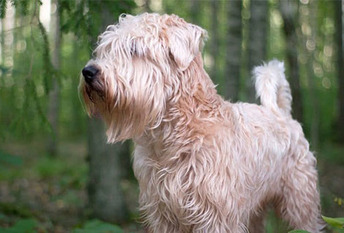The Scottish Deerhound’s harsh, somewhat wiry coat is very easy to care for, requiring only an all-over brushing and combing every week or so. He will also need a trim of his nails every few weeks if they aren’t worn down naturally. Grooming tools to have on hand include a slicker brush, a fine-toothed metal dog comb, and an electric nail grinder or a pair of heavy-duty dog nail clippers. An occasional bath will help to reduce any doggy odor.
The rest is basic care. Trim his nails as needed, usually once every week or two, and keep his ears clean and dry. Check the ears weekly for dirt, redness or a bad odor that can indicate an infection. If the ears look dirty, wipe them out with a cotton ball dampened with a gentle pH-balanced ear cleaner recommended by your veterinarian.
Deerhounds are athletes. They were designed to hunt deer twice their size, so they are built for stamina and endurance. They need several long walks every day and should be allowed to run whenever possible. Joggers enjoy Scottish Deerhounds because they can keep pace on long runs. Though they are well behaved indoors, Deerhounds do not make the best apartment dwellers because they require a bit of room to move around.
While nutrition and exercise are key to raising a puppy into a fit, well-muscled adult, the secret to a healthy, long-lived Deerhound (in addition to good genes) is being happy and well exercised. This is not a breed that handles stress well, nor is it a breed that will thrive with just a daily leash-walk around the city block. Fitness should be maintained throughout old age.
The Scottish Deerhound is a large dog and requires a lot of food. He should be fed high-quality, dry food. This helps to pervert potential oral health problems such as bad breath, cavities, and gum disease. Two meals daily or free feeding is better than providing one large meal.
If you get aDeerhoundpuppy from a breeder, they would give you a feeding schedule and it's important to stick to the same routine, feeding the same puppy food to avoid any tummy upsets. You can change a puppy's diet, but this needs to be done very gradually always making sure they don't develop any digestive upsets and if they do, it's best to put them back on their original diet and to discuss things with the vet before attempting to change it again.
Older dogs are not known to be fussy or finicky eaters, but this does not mean you can feed them a lower quality diet. It's best to feed a mature dog twice a day, once in the morning and then again in the evening, making sure it's good quality food that meets all their nutritional requirements. It's also important that dogs be given the right amount of exercise so they burn off any excess calories or they might gain too much weight which can lead to all sorts of health issues. Obesity can shorten a dog's life by several years so it's important to keep an eye on their waistline from the word go.
Treatscan be an important aid in training, but giving too many can cause obesity. Learn about whichhuman foodsare safe for dogs, and which are not. Check with your vet if you have any concerns about your dog’s weight or diet.Clean, fresh water should be available at all times. Because of the risk ofbloat, several smaller meals per day are preferable to one large meal, and strenuous exercise is not recommended before or after feeding time.
The average life span of the Scottish Deerhound is 8 to 11 years. Breed health concerns may includeallergies,bloat (gastric dilatation and volvulus), dilated cardiomyopathy, pseudoachondroplasia, cystine urolithiasis, hereditary factor VII deficiency,hypothyroidism, osteosarcoma, and pyometra.
If you have your Deerhound neutered, keep in mind that Deerhounds, like all the large breeds, should never be neutered under the age of a year, preferably after the dog is mature (at least two years of age). Detailed information on breed health can be found on the website of the breed’s parent club, theScottish Deerhound Club of America.
Deerhounds are moderately easy to train. They pick up new behavior quickly, especially when praise and food are the motivation, but some can be quite stubborn and simply choose to ignore the rules. The good news is that they are not particularly destructive or ill-behaved, so a Deerhound who doesn't listen is easier to live with than some other breeds. Practice makes perfect, so patience is necessary, but even the most stubborn Deerhound comes around in time. When your Deerhound isn't listening, you should never treat him harshly. They are sensitive dogs who will respond to harsh treatment by completely shutting down. Polite praise and encouragement will help motivate him to repeat good behavior and abandon bad.
Housebreaking is the only real training issue reported within the breed. Because they are sensitive, they do not do well in crates. This makes potty-training very difficult. The Scottish Deerhound puppy will need constant supervision, and the owner needs to watch for signals that the pup needs to go outside. Consistency and fastidiousness is the only way to housetrain a Deerhound.
This breed loves to run and Deerhounds excel in sports such as lure coursing. Of course, they love the breed ring and because of their gentleness, they make wonderful therapy dogs. Scottish Deerhounds are versatile and can be trained for many things.











